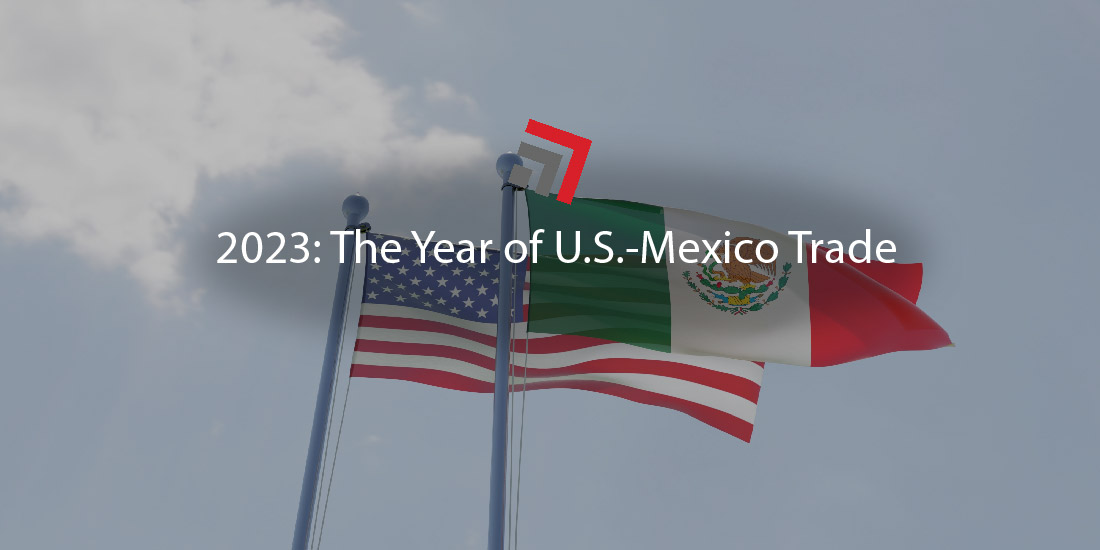This year, more business came from the south, and not the north.
Trade data, nearshoring trends, and the rising value of the peso all put a light on Mexico’s growing commercial relationship with the U.S.
U.S. top trade partner in 2023
Canada, last year’s right-hand man for U.S. trade, may be jealous that America has a new BTPF (best-trading-partner-forever).
In 2023, Mexico bridged a gap and became the top partner of the U.S. in two-way trade, ahead of Canada and China, respectively. Through October, U.S.-Mexico trade totaled $673 billion, which represented a 16 percent share of overall U.S. international trade.
While in previous years, Mexico has fallen awfully close to overtaking Canada, 2023 marks a breakthrough—Mexico is number one.
Nearshoring, automotive industry invests in Mexico
Mexico’s big year has a certain trend to thank. Nearshoring, the relocation of production and manufacturing operations to countries that are closer to the shipper, has become a popular strategy for U.S. companies.
Not only does Mexico border the U.S., but the country boasts bountiful building space and a large, typically low-cost, labor force. After devastating lead times and supply chain disruptions in China during the pandemic, many companies have invested in Mexico as an alternative conduit. The transportation is cheaper and quicker, while also having fewer trade concerns than China.
The automotive industry has been the biggest purveyor of nearshoring. In 2023, of the 226,792 Mexican jobs created from foreign private sector investment, 42 percent of them were automotive-related.
Earlier this spring, automaker Tesla announced it would build a $5 billion electric vehicle factory in Monterrey, to which Mexican authorities dubbed one of the biggest wins for its manufacturing sector in years.
The city is 140 miles south of Laredo, Texas (U.S. border) which means the future plant will be hours, not weeks, away from Tesla’s Austin headquarters. Due to economic uncertainty however, CEO Elon Musk has given more conservative estimates on when construction will actually begin.
Despite this year’s success, Mexico will continue to face competition from overseas countries, like India, Vietnam, and Thailand, as well as South America, for U.S. investment. China will also remain aggressive to preserve its dominant share of American imports.
The power of the peso
As Mexico benefits being on the receiving end of the U.S. nearshoring movement, the country’s currency has strengthened. Over the second half of 2023, the value of Mexico’s peso has been at its highest since 2015. Last week, the exchange rate was 17.30 pesos per one U.S. dollar.
An emboldened peso can impact transportation costs. Mexican logistics companies and motor carriers do business in pesos, however if they are engaged in cross-border shipments to the U.S., they’re typically paid in U.S. dollars for their services.
Experts advise U.S. shippers to monitor the exchange rate of the two currencies. Generally speaking, most agree a 20 peso-to-dollar ratio is a comfortable floor for transactions.
However, as the peso continues to strengthen via nearshoring investments, shippers should assume that the currency will remain hovering below this comfort zone. In return, they must be diligent when negotiating this new dynamic.
Final Thoughts
While Mexico certainly has its advantages for U.S. companies to invest in, the country is not immune to internal strife that may cause trade disruptions.
In August, a group of Mexican motor carriers threatened a nationwide truck driver strike due to their grievances with government corruption, rising operating costs, cartel violence, and cargo theft. The strike has since been postponed after Mexican officials showed a willingness to discuss these concerns, but the labor-related action, which would decimate cross-border trade, stays looming over the country.
According to Mexican authorities, 2023 will be in the books as the year with the most reported incidents of cargo theft in the country. Mexico’s National Association of Vehicle Tracking and Protection Companies reported that cargo theft registered a 9.5 percent year-over-year growth through November.
Contact one of our team members if you have any questions regarding this topic or any others in domestic logistics.
More blogs similar to this:



Recent Comments